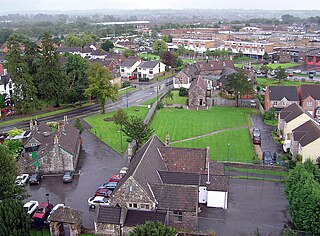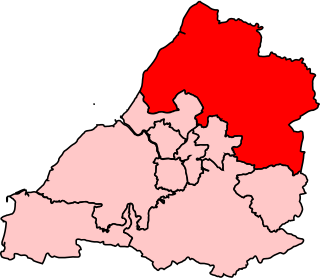
Grumbald's Ash Hundred (also spelled Grumbold's Ash) [1] was a subdivision of the county of Gloucestershire, England. Hundreds originated in the late Saxon period and lasted as administrative divisions until the 19th century. [2] It has been reported that the court was originally held under an Ash tree situated in Doddington parish, although this location would not be consistent with the previous split of hundred. [3] Its name survives in the Grumbolds Ash with Avening electoral ward of Cotswold district council. [4]
The hundred was divided into Upper and Lower divisions and comprised a total of 20 ancient parishes in the southeastern corner of the county. The Lower division comprised Acton Turville, Chipping Sodbury, Little Sodbury, Old Sodbury, Tormarton, West Littleton, Dyrham & Hinton, Wapley & Codrington and Dodington; the Upper division comprised Alderley, Badminton, Boxwell & Leighterton, Charfield, Didmarton, Hawkesbury, Hillesley, Horton, Oldbury-on-the-Hill, Tortworth and Wickwar. [5] [6] [7]
At the time of the Domesday Book, there were three hundreds in this area: Eddredestane, Bagstone and Hagmead, the last also known as Grimboldstow. Eddredestane later formed most of the Lower division of Grumbald's Ash Hundred and the other two the Upper division. [8]
Eddredestone Hundred also included the parish of Marshfield, which later became a detached part of Thornbury Hundred. The survey named four places in this hundred: Marshfield, Sodbury, Dodington and Tormarton. [9] Note West Littleton was formerly a tything of Tormarton. [10] Eddredestone was named after Eadred, King of the English 946-955, who established the "Three Shires Stone" in Marshfield, marking the boundary between Gloucestershire, Somerset and Wiltshire. [11]
Bagstone Hundred included Tortworth, Charfield, Wickwar, Tytherington and Iron Acton, the last two parishes later transferred to Thornbury Hundred. [12] Bagstone is the name of a hamlet in Wickwar parish which was the meeting place of the hundred. [10]
Hagmead Hundred included Hawkesbury, Horton, Badminton, Boxwell, Hillesley, Alderley, Oldbury-on-the-Hill, Little Sodbury and Didmarton, which became part of the Upper Division, plus Acton Turville and Dyrham & Hinton which formed, with Eddredestane, the Lower Division. [13] At the time of Domesday, Wapley was part of Swineshead Hundred, later transferring into the Upper division of Grumbold's Ash. [14]












